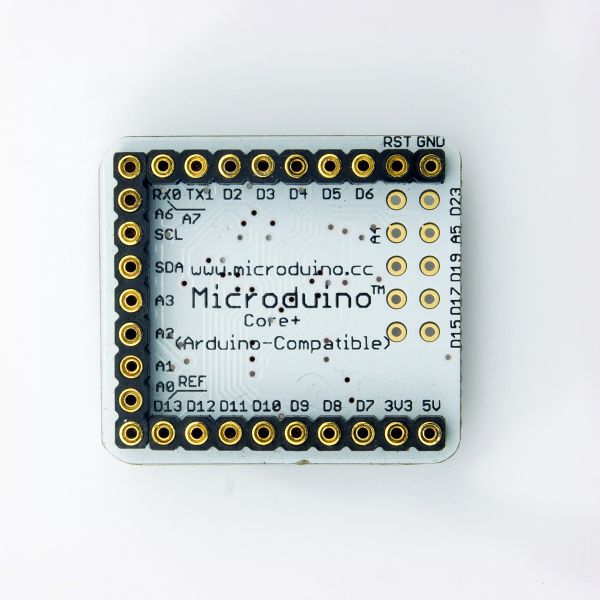“Microduino-Core+/ko”的版本间的差异
小 |
|||
| (未显示同一用户的1个中间版本) | |||
| 第1行: | 第1行: | ||
| − | {{Language|Microduino-Core+ | + | {{Language|Microduino-Core+}} |
{| style="width: 800px;" | {| style="width: 800px;" | ||
|- | |- | ||
| 第5行: | 第5行: | ||
[[file:Microduino-core+ -rect.jpg|400px|thumb|right|Microduino-Core+]] | [[file:Microduino-core+ -rect.jpg|400px|thumb|right|Microduino-Core+]] | ||
| − | '''[[Microduino-Core+]]''' | + | '''[[Microduino-Core+]]''' 는 '''[www.atmel.com Atmel]'''사의 ATmega644PA/ATmega1284P 시리즈를 메인칩으로 사용하고 있습니다. '''[[Microduino-Core|마이크로두이노 코어]]'''버전보다 성능이 향상된 모듈입니다.. |
'''[[Microduino-Core+]]''' has all features of –Core, can be stacked with modules through UPin-27 Microduino standard bus interface, as smart as '''[http://arduino.cc/en/Main/ArduinoBoardMega2560 Arduino Mega2560]''', but as small as a quarter. Moreover, '''[[Microduino-Core+]]''' has 10 more digital I/O ports than '''[[Microduino-Core]]''', provides 2 hardware serial ports, and more SRAM/Flash/EEPROM, it’s designed for high hardware resource required applications and designs. | '''[[Microduino-Core+]]''' has all features of –Core, can be stacked with modules through UPin-27 Microduino standard bus interface, as smart as '''[http://arduino.cc/en/Main/ArduinoBoardMega2560 Arduino Mega2560]''', but as small as a quarter. Moreover, '''[[Microduino-Core+]]''' has 10 more digital I/O ports than '''[[Microduino-Core]]''', provides 2 hardware serial ports, and more SRAM/Flash/EEPROM, it’s designed for high hardware resource required applications and designs. | ||
| + | |||
| + | '''[[Microduino-Core+|마이크로두이노 코어 플러스]]'''는 마이크로두이노 코어의 모든 기능을 가지고 있으며 UPin-27 마이크로두이노 기본 인터페이스를 이용해서 쌓아 올릴수 있다. '''[http://arduino.cc/en/Main/ArduinoBoardMega2560 Arduino Mega2560]'''보드 만큼 스마트하지만 사이즈는 1/4정도 작습니다. | ||
Microduino uses the same development environment as Arduino IDE, designers can use the Arduino IDE, Processing on Microduino for idea realization, prototype development and low volume production. Programs can be smoothly migrated from Core to Core+ without any modification. | Microduino uses the same development environment as Arduino IDE, designers can use the Arduino IDE, Processing on Microduino for idea realization, prototype development and low volume production. Programs can be smoothly migrated from Core to Core+ without any modification. | ||
2014年9月2日 (二) 15:36的最新版本
| Language | English |
|---|
|
Microduino-Core+ 는 [www.atmel.com Atmel]사의 ATmega644PA/ATmega1284P 시리즈를 메인칩으로 사용하고 있습니다. 마이크로두이노 코어버전보다 성능이 향상된 모듈입니다.. Microduino-Core+ has all features of –Core, can be stacked with modules through UPin-27 Microduino standard bus interface, as smart as Arduino Mega2560, but as small as a quarter. Moreover, Microduino-Core+ has 10 more digital I/O ports than Microduino-Core, provides 2 hardware serial ports, and more SRAM/Flash/EEPROM, it’s designed for high hardware resource required applications and designs. 마이크로두이노 코어 플러스는 마이크로두이노 코어의 모든 기능을 가지고 있으며 UPin-27 마이크로두이노 기본 인터페이스를 이용해서 쌓아 올릴수 있다. Arduino Mega2560보드 만큼 스마트하지만 사이즈는 1/4정도 작습니다. Microduino uses the same development environment as Arduino IDE, designers can use the Arduino IDE, Processing on Microduino for idea realization, prototype development and low volume production. Programs can be smoothly migrated from Core to Core+ without any modification. Microduino uses optiboot for bootloader, it takes less Flash than Arduino default engine and optimizes program uploading. Currently, there are 4 different configurations for Microduino-Core+ modules:
Different configurations in frequency and supply voltage:
| |||||||||||||||||||||||||||||||||||||||||||
目录Core vs Core+
| |||||||||||||||||||||||||||||||||||||||||||
Features
| |||||||||||||||||||||||||||||||||||||||||||
Specifications
| |||||||||||||||||||||||||||||||||||||||||||
Documents
| |||||||||||||||||||||||||||||||||||||||||||
Development
| |||||||||||||||||||||||||||||||||||||||||||
Applications
| |||||||||||||||||||||||||||||||||||||||||||
FQA
Buy
| |||||||||||||||||||||||||||||||||||||||||||
History
| |||||||||||||||||||||||||||||||||||||||||||
Pictures
|


